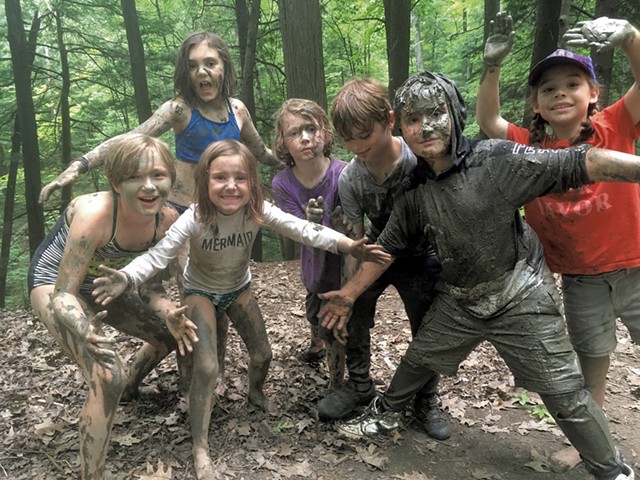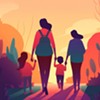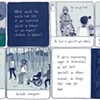Published September 1, 2020 at 10:00 a.m.
A few weeks ago, as I was listening to a podcast about going back to school, my 12-year-old turned to me and said, "Wait. We're still going to have to be social distancing in the fall? I thought it was going to be over!" Then he stomped out of the house.
We are all preparing for a school year that feels extremely unpredictable. All we know for sure is that it will not be the same as before COVID-19. As we learn more about a virus that makes being indoors more risky than being outdoors, I am haunted by three sentences I came across while scrolling through Sophie Lovett's Raising Revolutionaries blog in March:
"The situation we are facing is beyond compare, and I very much doubt that the world is going to be quite the same when we emerge from our respective periods of isolation. It is a once-in-a-lifetime chance to reflect on what our true priorities are for ourselves and our children. If that's completing worksheets then go for it — but if it's not, take this as permission to try something new."
As Joan Carey, environmental educator at Bonnyvale Educational Center in West Brattleboro, notes, "Most traditional academics can probably be done outside with the right systems or gear, but how do we take advantage of connecting with nature and place? What opportunities are here?"
I asked people who have been practicing outdoor education long before this moment what parents and teachers might want to consider as we prepare for the fall. I spoke with educators at four organizations across the state that run very different programs catering to a variety of audiences. I focused on their elementary and middle school programs, and what lessons they might hold for parents and teachers.
Outdoor learning this fall is going to look as different as the educators who are conducting it. Many programs in elementary schools focus on science standards, but, says Carey, "Outdoor time is not separate and apart." She regularly works with teachers who incorporate math and literacy into outdoor learning.
The vision of Julia Hunt, one of the founders of ReTribe in Underhill and Richmond, involves "a part that is sitting and a part that is doing" and lots of play — for example, writing a story that students can then act out in the forest.
Hunt suggests we take this moment as an opportunity to "rethink what it is we want children to grow up knowing."
"What is the outcome we are looking for?" she asks. As a starting place, she offered this answer: "people who can contribute to the world and create happiness within themselves."
Ross Doree, youth programs director of outdoor education program Crow's Path in Burlington — which my son has attended for many years — says that outdoor education today "is less about giving kids the right information and more focused on giving them opportunities to be deeply creative, connected, exuberant people. The outdoors is a limitless environment to develop those traits."
His program aims to nurture curiosity and teach kids to teach themselves. Being in nature, Doree says, "fills kids up so they can come back to the classroom rejuvenated."
John Hunt, another founder of ReTribe, Julia's partner and a citizen of the Nuhlegan Band of the Coosuk Abenaki Nation, points out that "knowing how to manifest what you have in your mind is a skill." Students at ReTribe learn that what they do has an impact on the group through activities such as gathering firewood and building fires.
Sean Beckett, director of natural history programming at North Branch Nature Center in Montpelier, puts it this way: "I think it will be helpful to be OK with the fact that this fall is not normal, and to be OK with not getting the same level of content. The goal is that kids are healthy, inspired, using their imaginations, learning, being curious, asking questions, investigating, exploring, coming up with hypotheses and asking new questions from what they have learned. We can see it as a big success if kids can stay curious — if we can cultivate the fire so it is still burning."
Many of these experts point out that when it comes to outdoor learning, the outcomes are often not what we expect. Carey suggests that it presents the opportunity to be extremely responsive to students' questions and interests, about topics such as seasons, weather and place. In nature, says Doree, success is not as narrowly defined as it often is in a classroom; it can therefore become internally defined by what resonates with each child.
Finally, many of these seasoned outdoor educators note that we will be asking a lot of educators who are not accustomed to teaching outside. Carey is frank about what teachers will need: professional development, planning time — a lot of it — and supplies, such as clipboards and outdoor clothing, for both students and teachers. Bonnyvale has developed a document for local school districts, "Teaching Outside 101" (find it at beec.org in the "BEEC Online" section) with detailed suggestions related to many of the logistical challenges facing schools that are contemplating how to set up outdoor learning from scratch. Working together outside could be very positive and restorative," says Carey, "but it only will be if the teachers have support."
I can attest to that. This summer, I was scheduled to co-teach a college course that I have taught for many years. My plans were more or less ready to go. When things changed and I had to adapt them to our new reality, it took me, and three professionals assigned to help me, 120 hours to prepare — for a mere 25 hours of teaching.
Good teachers are already doing the things these outdoor educators discuss inside their classrooms. As the school year begins, I'll be thinking about how I, as a parent, can advocate for more learning outside and support teachers in implementing it thoughtfully.
Heather Fitzgerald teaches field ecology and environmental science at the Community College of Vermont and Saint Michael's College.
This article was originally published in Seven Days' monthly parenting magazine, Kids VT.
More By This Author
Speaking of...
-

Emergency Eats Provides Restaurant Meals to Flood-Impacted Vermonters
Aug 10, 2023 -

From the Publisher: Still Here
Mar 15, 2023 -

COVID Long-Haulers Struggle With Debilitating Symptoms, Few Treatment Options
Nov 30, 2022 -

Mirroring a National Trend, RSV Hospitalizations Rise in Vermont
Oct 25, 2022 -

Essay: Natalie Miller Riffs on How Her Nightclub Survived the Pandemic
Sep 14, 2022 - More »
Comments
Comments are closed.
From 2014-2020, Seven Days allowed readers to comment on all stories posted on our website. While we've appreciated the suggestions and insights, right now Seven Days is prioritizing our core mission — producing high-quality, responsible local journalism — over moderating online debates between readers.
To criticize, correct or praise our reporting, please send us a letter to the editor or send us a tip. We’ll check it out and report the results.
Online comments may return when we have better tech tools for managing them. Thanks for reading.














































